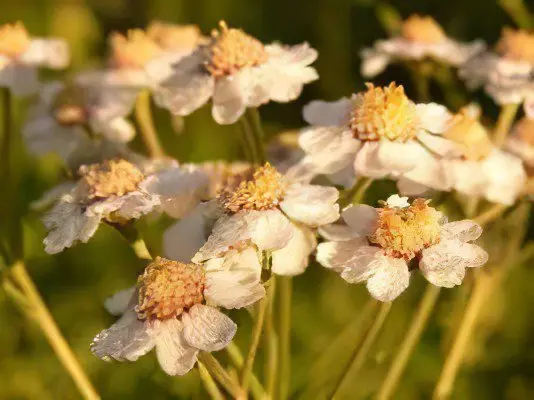Contents
Useful properties and use of sneezy grass
Description of sneezy grass

sneeze grass – perennial herbaceous plant of the Compositae family, with a creeping rhizome, with a straight stem, smooth, pubescent at the top, linear-lanceolate, serrate, sessile leaves. At the ends of the stems are thyroid inflorescences, consisting of many baskets. The flowers are white and yellow, flowering begins in June and continues until mid-August.
Plant height is 30–70 cm. Sneezy grass grows almost everywhere in the CIS. She chooses floodplain forests, river banks, moist areas in the shade, ditches, peat bogs. Collect grass during flowering, dry in the shade. October is the time of harvesting the root.
Useful properties of sneezy grass
The aerial part of the plant is used as a medicinal raw material. Although its chemical composition has not been studied enough, it is known that Achilles alkaloids, essential oil, organic acids, and a bitter substance were found in it. Tannins were found in the roots, which have very noticeable astringent properties and give the grass bitterness..
The rhizomes contain inulin, a plant polysaccharide that is a polymer of glucose and is similar to starch and fiber. The plant has anti-inflammatory, analgesic, antiseptic and wound healing effects.
The use of sneezing grass
The use of the plant is popular only in folk medicine. Means prepared on the basis of sneezy grass improve the functioning of the gastrointestinal tract. Decoctions assist in the treatment in the form of lotions for hernia, hemorrhoids. The use of a decoction inside is useful for pulmonary tuberculosis, to improve appetite, for enterocolitis, diarrhea, gastric ulcer and duodenal ulcer.
This remedy rinses the mouth with toothache, with colds (tonsillitis). Take the herb to stop uterine bleeding and bloody urine. The name of the plant was not chosen by people by chance: the crushed powder of leaves and flower baskets causes sneezing. It is prescribed for various acute respiratory infections. Freshly ground in a meat grinder, sneezy grass is applied to heal purulent wounds and ulcers.
Infusion of sneezy grass: 5-6 g of grass should be infused in a thermos for two hours with 1 cup of boiling water. You need to drink the remedy 1-2 tablespoons 3-4 times a day 15-20 minutes before meals. The infusion is especially indicated for pulmonary tuberculosis.
The content of inulin in the herb during treatment has a positive effect on improving metabolism and cleansing the body, helps to reduce sugar levels, and reduces appetite. The use of herbal raw materials in the form of decoctions helps to normalize the absorption of food, eliminates violations of the intestinal flora, is indicated for obesity and constipation.
Contraindications to the use of sneezy grass
There are no contraindications to the use of this plant.









